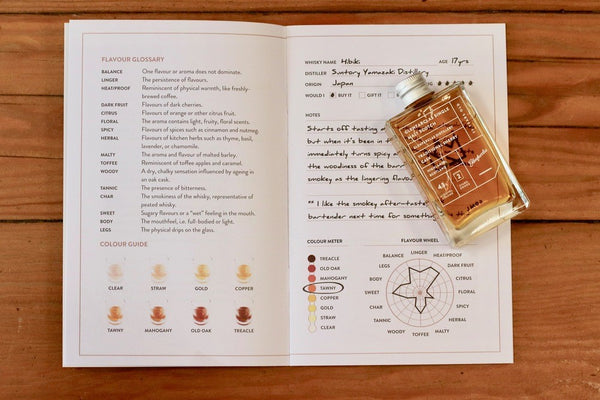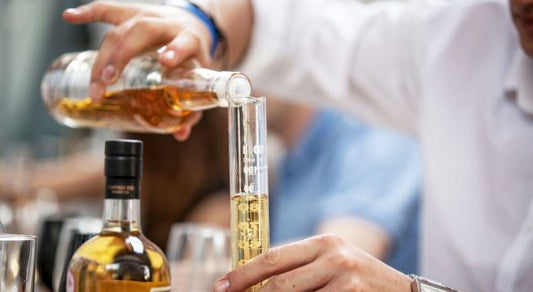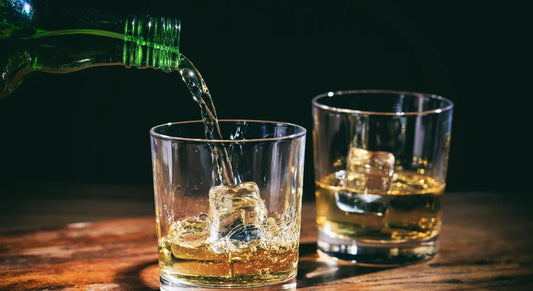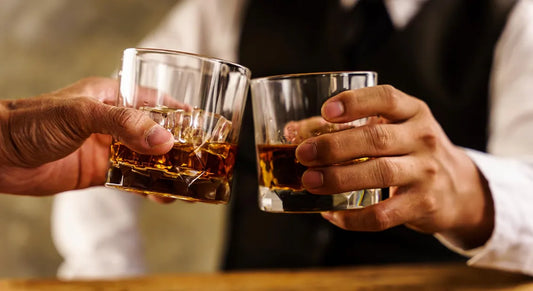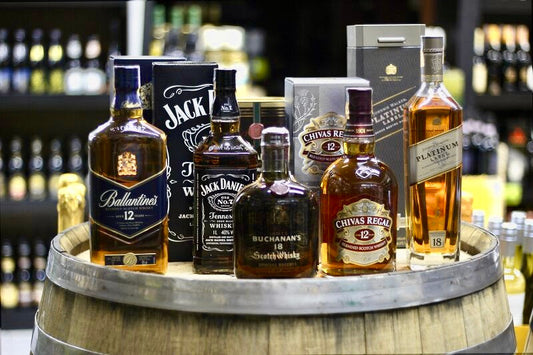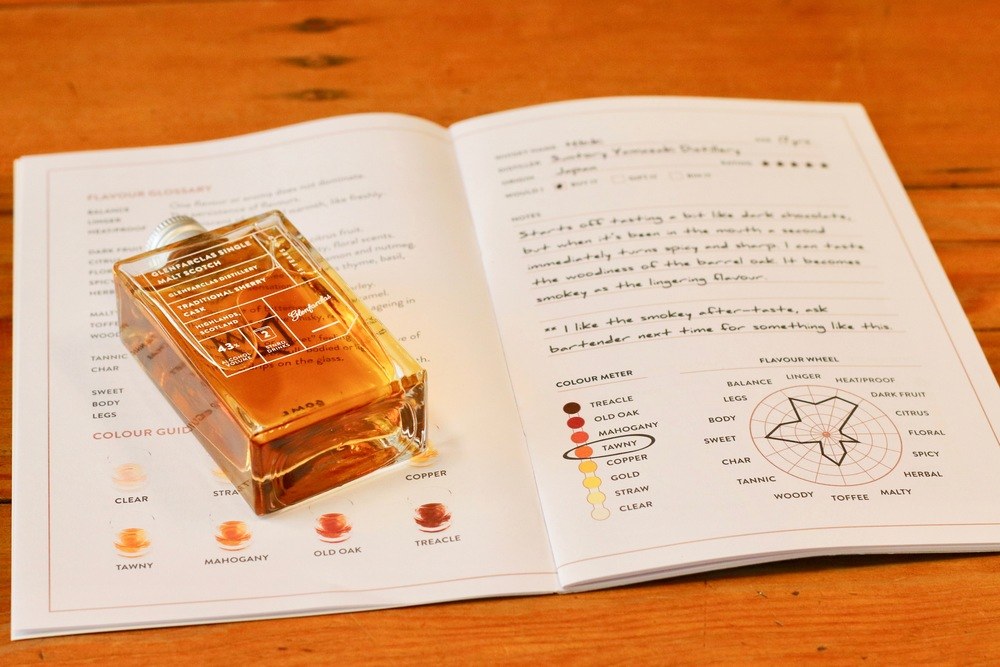
How to use our Whisky Loot journal
So you’re set to receive your first Whisky Loot box!
Within it, you’ll notice a journal. This journal is for you to mark down your observations, thoughts and tasting notes about each whisky you try. This will help you zero in on the qualities of your favourite drams as you explore. Here’s all you need to know about how to use this journal to its full potential.
Nose, taste, finish and balance
There are four main components of tasting whisky seriously. The first step is the nose or smell of a whisky. After the nose comes the taste, essentially the flavours of the whisky, this is sometimes called the "palate". Usually, a few sips are needed to completely analyse the whisky’s flavours, with the first drink being small and subsequent tastes a bit larger. The purpose of the first sip is usually to assess texture or weight, whilst the latter sips should coat the mouth and really let you get to grips with the dram's flavours.
Lastly, the finish. Assessing finish is as important as taste. As flavours rest in the mouth, they change, and a whisky’s finish could be drastically different from its initial taste. To determine a whisky’s balance, each flavour must be considered on its own and then as a group. If no individual flavour overpowers the others, then the whisky is evenly balanced.
For whiskies above 50 per cent ABV, the process may be repeated after adding a small amount of water to break up the whisky’s oils.
Getting started
If you’re new to the whisky game, you may have a lot of questions about how to drink and truly appreciate a fine glass of whisky. And you’re in luck because we’ve got a quick guide right here to get you going.
Be sure to set aside plenty of time to try each whisky and remember to have fun with it!
The whisky flavour palette
Developing your own whisky palette is a fun journey, and our Whisky Loot journal is here to guide you. Once you’ve got a grasp of your unique whisky tastes, it’s time to really dig into the minutiae.
There’s a whole host of words to describe the physical attributes of each whisky you try. In your Whisky Loot journal, you’ll be tracking these attributes and mapping an overall picture of the whisky’s quality.
- Body
This describes how the whisky feels in your mouth. If the whisky has less weight, you would describe it as "light", whilst denser, thicker drams are "full-bodied".
- Legs
Good whisky leaves physical drips on the glass. These are called legs. The slower the legs fall down the glass, the higher the alcohol content, but also the higher the amount of oaky extracts and oils – which often produce flavours.
- Linger
When you rank whiskies by lingering, you’re judging how persistent the flavours are. A whisky that has a short-lived flavour will rank low in the linger category.
- Heat/proof
This is the quality of the whisky’s physical warmth on the palate as a result of strength. High heat can reminiscent of freshly-brewed coffee or warming spices like cinnamon sticks.
Basic flavours and aromas
Next up you’ve got the basic flavour descriptions for whiskies. You should be marking down flavour notes in your journal while you drink. For consistency, use the following glossary of terms.
- Dark fruit
Dark, fruity flavours recall the taste of cherries. They may be sweet or a little tart. Often common in sherried or wine-cask drams.
- Sweet
Not to be confused with sweetness of fruits or malt, sweet refers to an explicitly sugary taste and sensation that tends to linger, often in a whisky's finish.
- Citrus
Orange is a common taste in whiskies, especially spicier sherried ones. Notes of other citrus fruits may pop up, as well.
- Herbal
Herbal flavours recall fresh, verdant ingredients like chamomile, basil, or lavender.
- Floral
Floral is the descriptor of the flower-like aroma that often appears with herbal or citrus flavours. Honeysuckle, rose and orange blossom are all floral aromas occasionally encountered.
- Spicy
Cinnamon and nutmeg are the most common spicy flavours, and they often pop up next to citrus undertones.
- Malty
This is an aroma of malted barley – sweet, and often a little like pastry or malted milkshakes. It’s a very common aroma considering what whisky is made from.
- Toffee
Any flavour reminding you of caramel, toffee apples or other candied sweets falls under the toffee umbrella.
- Woody
Whisky is aged in casks, and they have a huge impact on the flavour. To describe a whisky as “woody” is to detect the presence of oaky aromas and flavours that can range from sweet and vanilla-y, to drying and slightly astringent.
- Tannic
Tannic describes a tart, slightly mouth-drying sensation, that lingers on the taste buds. Particularly associated with wine and sherry cask whiskies.
- Char
Peated whisky almost always includes a char flavour, but it can also be present in unpeated whisky, depending on how deeply a cask has been toasted. Char is the “smokiness” you taste in the whisky.
Whisky hues

Whisky comes in a variety of colours. The different hues can be helpful in recognising whiskies at a glance. The lighter colours on the whisky spectrum are clear, straw, gold and copper. The darker colours are tawny, mahogany, old oak and treacle. A whisky’s age and cask maturation determine its colour – Bourbon barrel aged whiskies tend to be lighter, whilst sherry cask whiskies are deeper in colour.
Common mistakes
Avoid these common missteps while tasting new whiskies, as they may lead to erroneous results.
- Adding ice
Ice cubes can tighten the molecules in your whisky, preventing some of the flavour and aromas from being released properly. You’ll get a somewhat diluted flavour if you sip your whisky with ice.
- Chilling your whisky
Likewise, storing your whisky in the fridge or other cold areas before drinking is another common mistake. Whisky isn’t a can of beer and cooling it down too much will give you an inaccurate taste.
- Diving nose-first into the glass
You’ll get more accurate results if you place the glass gently at your lip and let it move slowly from side to side, breathing normally. Doing it this way allows the aromas to break up a bit in the air before you sense them.
- Wearing overpowering scents
If you commonly use colognes, perfumes or strongly-scented soaps, you may be messing with your whisky results. If you find yourself wondering why someone would make an aftershave-flavoured whisky, you may be picking up your own flavour.
- Tasting in the wrong room
Just like your personal brand of body wash can overtake the whisky you’re trying, so too can distractions from elsewhere in the room. Be sure to select a room for your whisky taste tests that is calm and quiet.
Other helpful tips for more experienced tasters
Once you’ve really gotten comfortable with the basics, you can take some of these further tips into consideration.
- Utilize a palete cleanser
Coffee or cocoa make wonderful palette cleansers if you’re tasting multiple whiskies in a sitting.
- Bring the whisky up to body temperature
Tulip shaped glasses with stems are the ideal glass to taste whisky from. By cupping the glass in your palm and covering the rim loosely with your other hand, you can gently bring the whisky to body temperature, which is ideal for flavour and aroma quality. Once you notice condensation on the top of the glass, it’s time to start breathing in the whisky. Take a look at our top recommended Whisky glasses.
- Don’t drink all of it
Spit out some of your taste tests, if you can stand to do so. This will keep you alert for longer tasting sessions.
- Consider time
You’ll want to taste each whisky several times before you make your final judgement. Don’t rush through the process, and keep note of when each flavour makes its appearance. Whisky flavours will change as you hold the drink in your mouth.
- Assess the whisky’s “shape”
Hold the whisky in your mouth long enough to truly get a sense of its shape. Tilt your head back a bit and keep your mouth slightly open, letting air in and alcohol out. Pay close attention to the length of the whisky’s finish and how the flavours form.
Out of pages in your journal? Contact our support team so we can hook you up with another journal!
